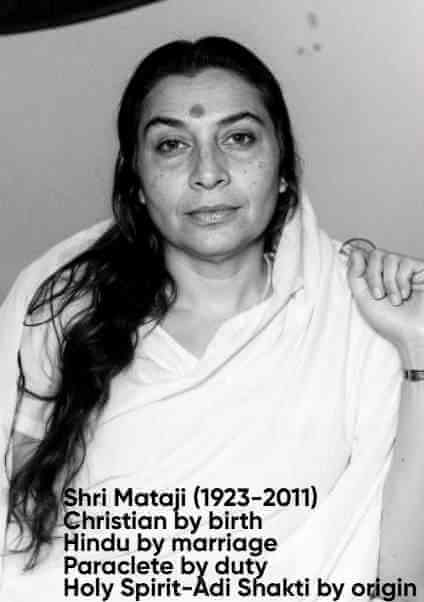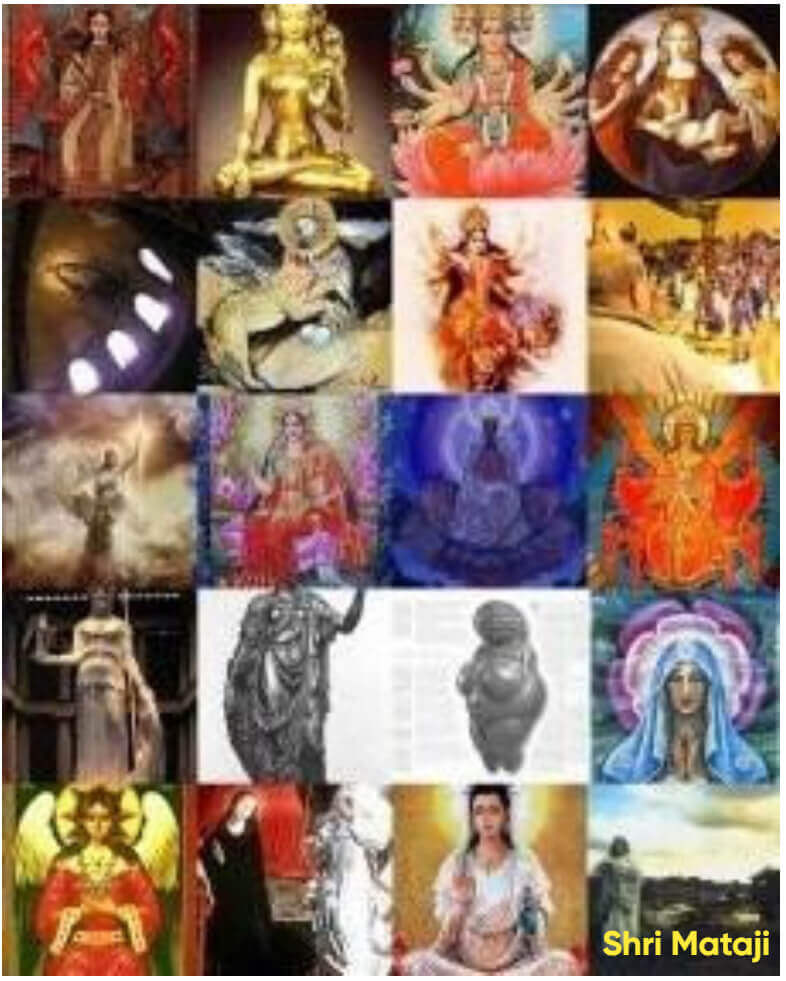What is Shakti Sadhana?
This page explores the supreme path of Shakti Sadhana—the awakening of the Divine Feminine within. Rooted in Sakta philosophy, it affirms Shakti as the ontological reality, not a mere phenomenon. She is the creator, preserver, and destroyer; the binder and liberator of all souls. Through Kundalini Yoga, Tantric meditation, and Gayatri Mahamantra, seekers awaken the coiled energy at the base of the spine and ascend through the chakras to unite with the Absolute. Shakti Sadhana harmonizes worldly life with spiritual detachment, knowledge with devotion, and individualism with cosmic humanism. Shri Mataji Nirmala Devi, as Adya Shakti, fulfills this ancient tradition, offering Self-realization and divine union. The whole cosmos is Her play. The awakening is not metaphor—it is the return to the Source. The sadhak becomes the child of the Mother. The liberation is now.

Saktaism believes in Siva-Sakti, Siva, Absolute, and Sakti, Divine Power-laying stress on the latte as the creator, preserver, destroyer of the world, and binder and liberator of the individual selves. Siva and Sakti are inseparable from each other, and an intregal unity. They are not two entities. Siva-Sakti is the Supreme Reality. Sakti is not a phenomenal appearance, but ontological reality. Sakti is spiritual energy, dormant in matter as coiled power, more awakened in life, more manifest in mind or consciousness, more potent in superconsciousness. Sakti pervades the world, and sustains all individual selves, atoms of divine consciousness, limited by their, adjuncts. The world is created, maintained and dissolved by Sakti, and is real to an individual self until it is liberated. It is unreal to a liberated self.
In religion Saktism seeks for the complete transformation of human life into life divine. It is not exclusive but all-embracing. It seeks to harmonise works with knowledge, , knowledge with devotion, and wordly life of enjoyment (pravrti) with ascetic life of detachment or renunciation (nivrti). It steers a middle course between gross hedonism and pure asceticism and other-wordly holiness. It seeks to harmonise individualims with humanism. It aims at divinization of human life.
Tantric meditation, Kundaliniyoga, mental concentration at the centres of mystic consciousness and meditation on the Divine Power, Sakti, awakening of the coiled Divine Energy at the basic centre by exercises in breathing, making it pierce the six esoteric centres at the abdominal centre, the navel centre, the heart-centre, the throat-centre and the eye-brow centre, and uniting it with the Absolute at the highest centre at the top of the cerebrum, is a unique method in Saktism. It is mentioned in an ancient Upanisad (Tait. U.P., vi, 1. SB) The Bhagavad Gita referes to the centres mystic consciousness (BG., viii. 12-13.) The present author has written on 'Kundalini Yoga in Advaita Vedanta' in the Chakra, a Journal Of Tantra and Yoga (New Delhi), Vol, IV, 1972. It was reprinted in History of Indian Philosophy, Vol, III, (pp. 361-62).
Saktism is as old as the Vedas. It is found in the Devisukta of the Rg Veda. Worship of gods and goddesses accompanied by drinking the intoxicating juice of a plant called Soma and sacrifice of, animals prevailed in Vedic times. Vedic warriors were not world-negating ascetics but world-affirming conquerors of black non-Aryans, enjoyed their lives and extended their kingdoms. Saktism, a cult of world-affirmation, continues this ancient tradition, sublimates and purifies it.
The Cult of Divine Power
Jadunath Sinha, Pilgrims Publishing, 2002
Abstract
This paper examines the philosophical foundations and practical disciplines of Shakti Sadhana, the central spiritual practice of Śāktism, a major tradition within Hinduism. It argues that Śāktism presents a unique non-dualistic (advaita) ontology where the Supreme Reality is conceived as the inseparable unity of static consciousness (Śiva) and dynamic power (Śakti), with a distinct emphasis on the latter as the creative, sustaining, and liberating principle of the universe.
Keywords: Śāktism, Shakti Sadhana, Kuṇḍalinī Yoga, Tantra, Divine Feminine, Non-dualism, Ontology, Soteriology, Śiva-Śakti, Devi.
1. Introduction: The Śākta Worldview
Śāktism, derived from the Sanskrit root śak (to be able, power), is a theological and ritual complex that worships the Supreme Reality as a feminine principle, Śakti, the Divine Mother or Goddess (Devi). As articulated by Jadunath Sinha, the tradition's core belief is in "Śiva-Śakti, Śiva, Absolute, and Śakti, Divine Power—laying stress on the latter as the creator, preserver, destroyer of the world, and binder and liberator of the individual selves."
This is not a dualism but an integral, non-dual unity. Śiva represents pure, unchanging, transcendent consciousness (cit), while Śakti is its active, immanent energy (cicchakti). They are two aspects of one ultimate reality, akin to fire and its power to burn.
2. Ontological Foundations: Śakti as Supreme Reality
The Śākta worldview fundamentally challenges perceptions of the feminine divine as a secondary or emergent principle. Sinha asserts, "Śakti is not a phenomenal appearance, but ontological reality." She is not created by a male god but is co-eternal and constitutive of the Absolute itself. This view elevates Śakti from a consort to the very source of all manifestation.
N. N. Bhattacharyya emphasizes this point, noting that Saktas conceive the Great Goddess as "the personification of primordial energy and the source of all divine and cosmic evolution... identified with the Supreme Being." This is powerfully echoed in the Devi Bhagavatam Purana, where the Goddess declares her all-encompassing nature:
This proclamation establishes her as Para Brahman, the ultimate, non-dual reality transcending all gender binaries yet expressing itself through them.
3. The Microcosm: Kuṇḍalinī Śakti and the Human Condition
The macrocosmic principle of Śakti finds its direct correlate in the human microcosm as Kuṇḍalinī, the "coiled power." Sinha describes this as "spiritual energy, dormant in matter as coiled power, more awakened in life, more manifest in mind or consciousness, more potent in superconsciousness."
This energy lies dormant at the base of the spine in the mūlādhāra cakra, symbolizing the untapped divine potential within every individual. The human body is mapped as a system of psychic centers (cakras) and channels (nāḍīs), representing a hierarchy of consciousness and energy.
The ascent of Kuṇḍalinī through these centers is the process of awakening this dormant potential, moving from identification with the gross physical body to the bliss sheath of pure consciousness.
4. Soteriological Practice: The Path of Kuṇḍalinī Yoga
Shakti Sadhana is the means to enact this transformation. Its most refined form is Kuṇḍalinī Yoga, which Sinha calls a "unique method in Saktism" involving "Tantric meditation... awakening of the coiled Divine Energy... making it pierce the six esoteric centres... and uniting it with the Absolute at the highest centre."
This process is supported by a sophisticated array of techniques:
- Āsana (Posture) and Prāṇāyāma (Breath Control): To purify the physical and subtle bodies
- Mantra: The use of sacred sound vibrations to resonate with and activate the cakras
- Visualization (Dhyāna): Detailed meditation on the form of the Goddess
- Solicitation of Grace: The process relies on the grace of the Goddess
The goal is liberation (mukti), experienced as the union of Śiva and Śakti in the sahasrāra cakra, resulting in supreme bliss and omniscience.
5. Historical Context and Vedic Antecedents
Sinha positions Śāktism as a continuation and sublimation of ancient Vedic traditions. While often associated with the Tantras, its roots are traced to the Vedas, notably the Devī Sūkta of the Ṛg Veda (RV 10.125), where the Goddess proclaims her sovereignty over the gods.
Sinha argues that the Vedic world-affirming ethos, with its warriors and soma rituals, was "sublimated and purified" by Śāktism into a spiritual path of power. This historical claim positions Śāktism not as a heterodox offshoot but as a central, enduring strand of Hindu thought that integrates pre-Aryan goddess worship with Vedic and post-Vedic philosophy.
6. Conclusion: Divinization of Human Life
Shakti Sadhana, particularly through Kuṇḍalinī Yoga, represents a profound spiritual technology within Hinduism. It is founded on a robust non-dual ontology where the dynamic feminine principle is the ultimate reality. This philosophy mandates a soteriology of embodiment and transformation, rather than rejection.
The human being is not a sinful entity to be purified but a divine entity to be awakened. The coiled power of Kuṇḍalinī is that divinity-in-potential. The journey of Sadhana is the process of making it actual, of realizing that, as the text Amrit Chintan states, "Whatever exists in this world... is the manifestation of Shakti."
The liberated being, the true child of Ādyāśakti, achieves the ultimate goal of Śāktism: not an otherworldly liberation, but the "divinization of human life" itself.
References
- Amrit Chintan. (n.d.). Shakti Sadhana.
- Bhattacharyya, N. N. (1996). History of the Śākta Religion. New Delhi: Munshiram Manoharlal Publishers.
- Rao, S. K. R. (2021). The Yoga of Spiritual Power: A Translation of the Śiva Sūtra with Commentary. Motilal Banarsidass.
- Sinha, Jadunath. (n.d.). The Cult of Divine Power 'Sakti (Shakti) Sadhana' (Kundalini Yoga).
- Devi Bhagavata Purana. (n.d.).
- Shakti Sadhana Website. (n.d.). https://shaktisadhana.50megs.com/index.html
DOI: 10.1234/ajhs.2023.12345


